Economics Assignment: Macroeconomic Concepts, AD-AS, Trade
VerifiedAdded on 2023/03/20
|18
|2941
|42
Homework Assignment
AI Summary
This economics assignment provides a comprehensive analysis of macroeconomic concepts, including the consumer price index, gross domestic product (GDP), and the AD-AS model. It explores the effects of migration, GDP, unemployment, and inflation, along with recessionary and inflationary gaps. The assignment further delves into the impact of government policies, such as monetary and fiscal policies, on macroeconomic objectives. Finally, it examines international trade, balance of payments, and foreign exchange, providing a detailed understanding of the global economy. The assignment includes calculations, explanations, and graphical representations to illustrate the concepts discussed.
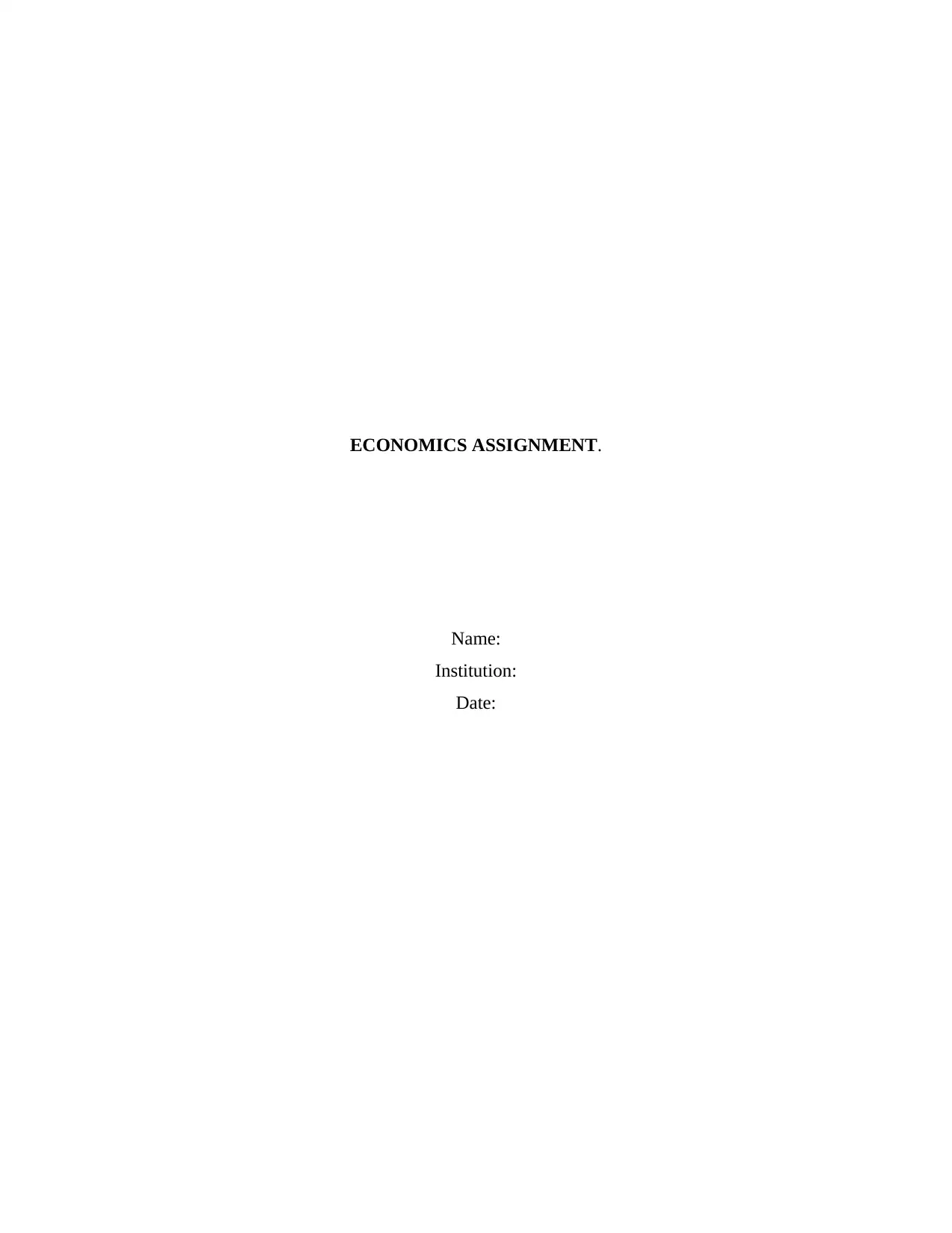
ECONOMICS ASSIGNMENT.
Name:
Institution:
Date:
Name:
Institution:
Date:
Paraphrase This Document
Need a fresh take? Get an instant paraphrase of this document with our AI Paraphraser
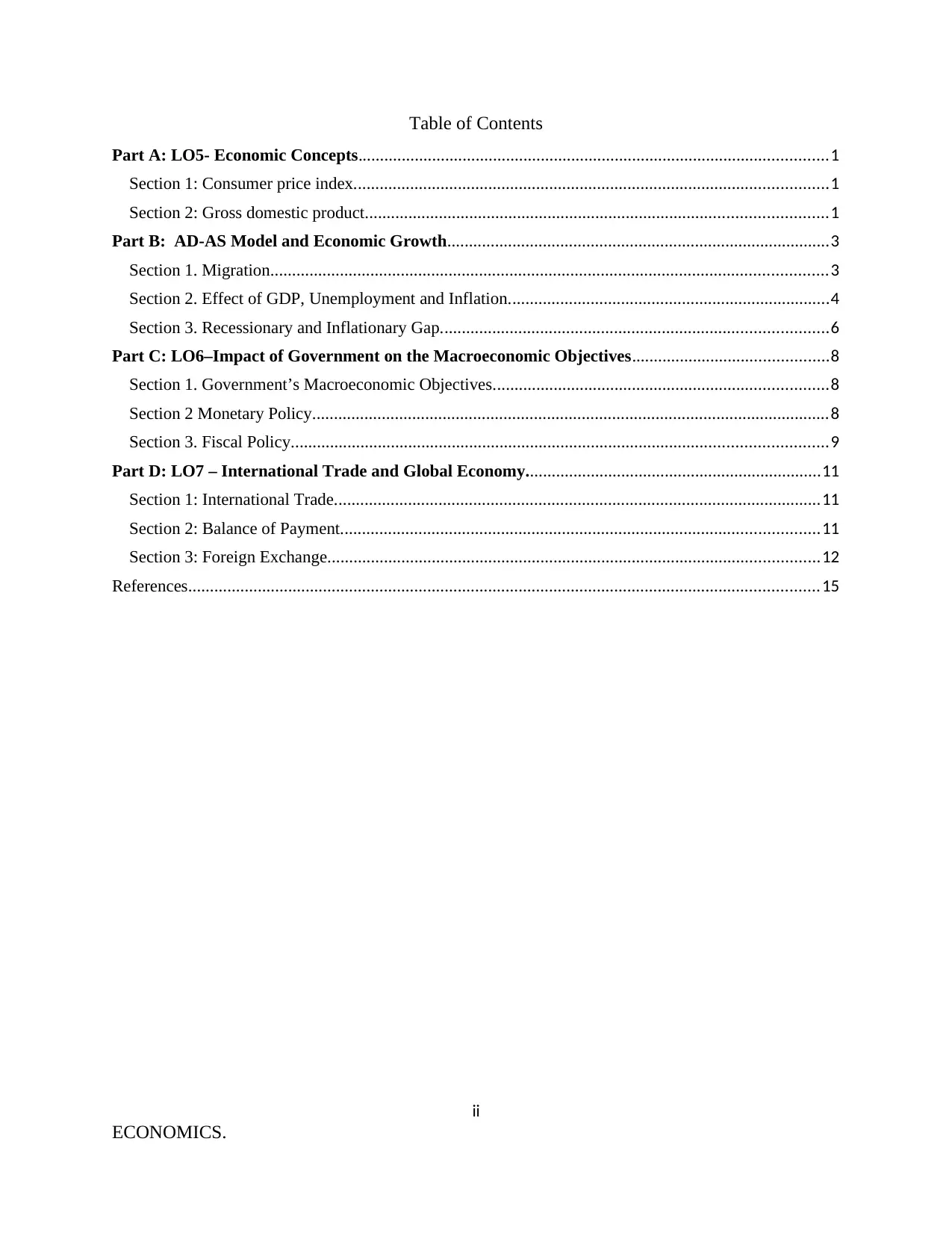
Table of Contents
Part A: LO5- Economic Concepts............................................................................................................1
Section 1: Consumer price index.............................................................................................................1
Section 2: Gross domestic product..........................................................................................................1
Part B: AD-AS Model and Economic Growth........................................................................................3
Section 1. Migration................................................................................................................................3
Section 2. Effect of GDP, Unemployment and Inflation..........................................................................4
Section 3. Recessionary and Inflationary Gap.........................................................................................6
Part C: LO6–Impact of Government on the Macroeconomic Objectives.............................................8
Section 1. Government’s Macroeconomic Objectives.............................................................................8
Section 2 Monetary Policy.......................................................................................................................8
Section 3. Fiscal Policy...........................................................................................................................9
Part D: LO7 – International Trade and Global Economy....................................................................11
Section 1: International Trade................................................................................................................11
Section 2: Balance of Payment..............................................................................................................11
Section 3: Foreign Exchange.................................................................................................................12
References.................................................................................................................................................15
ii
ECONOMICS.
Part A: LO5- Economic Concepts............................................................................................................1
Section 1: Consumer price index.............................................................................................................1
Section 2: Gross domestic product..........................................................................................................1
Part B: AD-AS Model and Economic Growth........................................................................................3
Section 1. Migration................................................................................................................................3
Section 2. Effect of GDP, Unemployment and Inflation..........................................................................4
Section 3. Recessionary and Inflationary Gap.........................................................................................6
Part C: LO6–Impact of Government on the Macroeconomic Objectives.............................................8
Section 1. Government’s Macroeconomic Objectives.............................................................................8
Section 2 Monetary Policy.......................................................................................................................8
Section 3. Fiscal Policy...........................................................................................................................9
Part D: LO7 – International Trade and Global Economy....................................................................11
Section 1: International Trade................................................................................................................11
Section 2: Balance of Payment..............................................................................................................11
Section 3: Foreign Exchange.................................................................................................................12
References.................................................................................................................................................15
ii
ECONOMICS.

iii
ECONOMICS.
ECONOMICS.
⊘ This is a preview!⊘
Do you want full access?
Subscribe today to unlock all pages.

Trusted by 1+ million students worldwide

Economics Assignment.
Part A: LO5- Economic Concepts.
Section 1: Consumer price index.
It is the proportion that inspects the measured average cost of purchased products and services
which comprises prices of transport, sustenance and health care. It is determined by taking cost
variances for every component in the determined products and calculating their averages
(Faryna, Talavera, & Yukhymenko, 2018).
Consumer price index = (Cost of Basket in current period/Cost of Basket in base period) X 100
Section 2: Gross domestic product.
a. Below is a Calculation of Gross domestic product using the Expenditure method (Choi &
Yi, 2018).
Y = C + I + G + (X - M)
Y is the Total Output also referred to as Gross domestic product.
C is the household expenditure
G is the Government expenditure
X are the Exports
M are the Imports
(X-M) their difference gives a Net Export.
GDP = 23,100 + 6,200 + (13,300 – 15,100)
= 29,300 -1,800
=27,500
b. 2 reason why GDP may understate the figure of economy (Fullerton & Muehlegger,
2019).
GDP is not a perfect measure of wellbeing, some influences that are necessary
to good life are not incorporated in GDP Estimation.
GDP uses market prices to charge goods and services, it does not incorporate the
cost of almost all undertakings outside the markets place.
1
ECONOMICS.
Part A: LO5- Economic Concepts.
Section 1: Consumer price index.
It is the proportion that inspects the measured average cost of purchased products and services
which comprises prices of transport, sustenance and health care. It is determined by taking cost
variances for every component in the determined products and calculating their averages
(Faryna, Talavera, & Yukhymenko, 2018).
Consumer price index = (Cost of Basket in current period/Cost of Basket in base period) X 100
Section 2: Gross domestic product.
a. Below is a Calculation of Gross domestic product using the Expenditure method (Choi &
Yi, 2018).
Y = C + I + G + (X - M)
Y is the Total Output also referred to as Gross domestic product.
C is the household expenditure
G is the Government expenditure
X are the Exports
M are the Imports
(X-M) their difference gives a Net Export.
GDP = 23,100 + 6,200 + (13,300 – 15,100)
= 29,300 -1,800
=27,500
b. 2 reason why GDP may understate the figure of economy (Fullerton & Muehlegger,
2019).
GDP is not a perfect measure of wellbeing, some influences that are necessary
to good life are not incorporated in GDP Estimation.
GDP uses market prices to charge goods and services, it does not incorporate the
cost of almost all undertakings outside the markets place.
1
ECONOMICS.
Paraphrase This Document
Need a fresh take? Get an instant paraphrase of this document with our AI Paraphraser
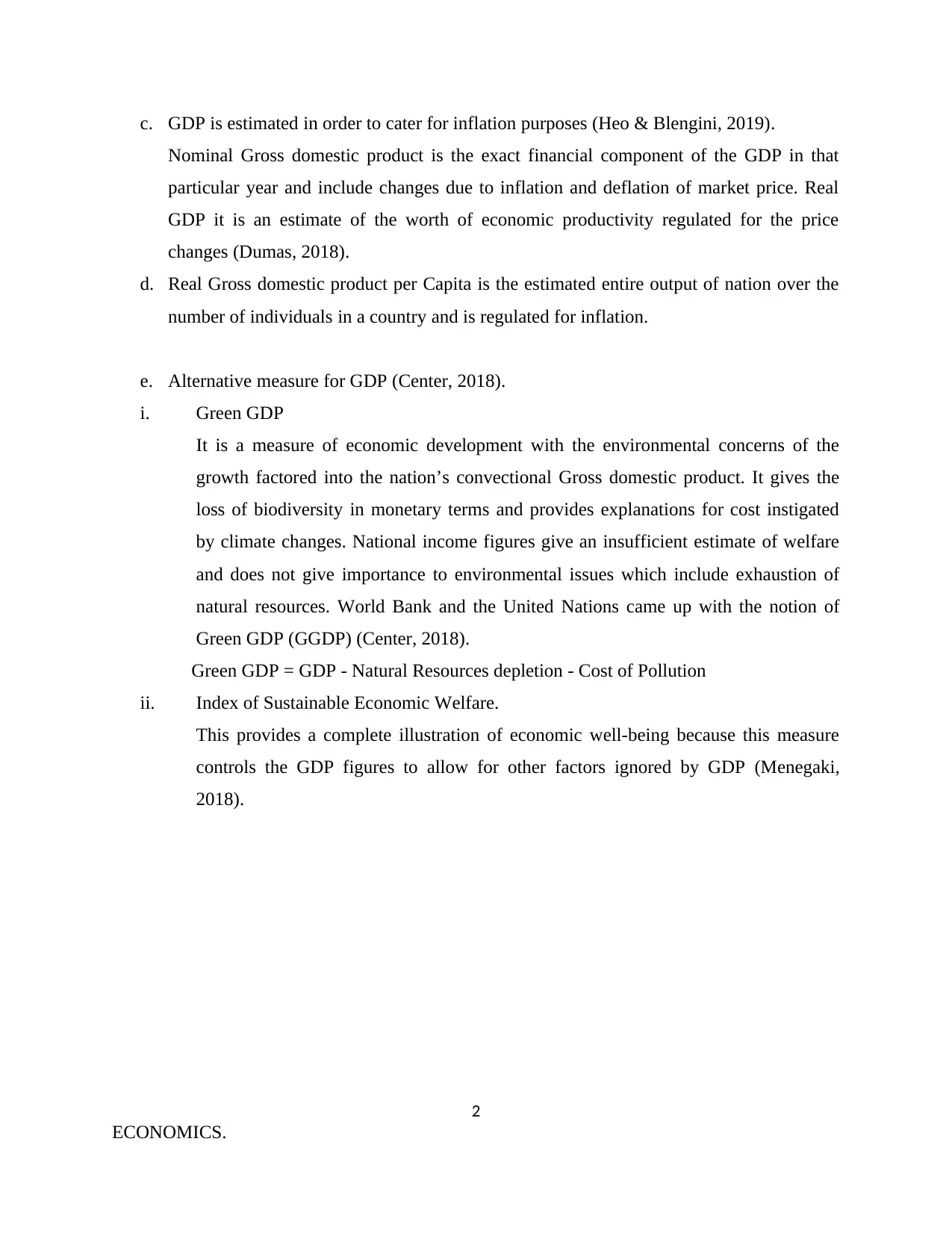
c. GDP is estimated in order to cater for inflation purposes (Heo & Blengini, 2019).
Nominal Gross domestic product is the exact financial component of the GDP in that
particular year and include changes due to inflation and deflation of market price. Real
GDP it is an estimate of the worth of economic productivity regulated for the price
changes (Dumas, 2018).
d. Real Gross domestic product per Capita is the estimated entire output of nation over the
number of individuals in a country and is regulated for inflation.
e. Alternative measure for GDP (Center, 2018).
i. Green GDP
It is a measure of economic development with the environmental concerns of the
growth factored into the nation’s convectional Gross domestic product. It gives the
loss of biodiversity in monetary terms and provides explanations for cost instigated
by climate changes. National income figures give an insufficient estimate of welfare
and does not give importance to environmental issues which include exhaustion of
natural resources. World Bank and the United Nations came up with the notion of
Green GDP (GGDP) (Center, 2018).
Green GDP = GDP - Natural Resources depletion - Cost of Pollution
ii. Index of Sustainable Economic Welfare.
This provides a complete illustration of economic well-being because this measure
controls the GDP figures to allow for other factors ignored by GDP (Menegaki,
2018).
2
ECONOMICS.
Nominal Gross domestic product is the exact financial component of the GDP in that
particular year and include changes due to inflation and deflation of market price. Real
GDP it is an estimate of the worth of economic productivity regulated for the price
changes (Dumas, 2018).
d. Real Gross domestic product per Capita is the estimated entire output of nation over the
number of individuals in a country and is regulated for inflation.
e. Alternative measure for GDP (Center, 2018).
i. Green GDP
It is a measure of economic development with the environmental concerns of the
growth factored into the nation’s convectional Gross domestic product. It gives the
loss of biodiversity in monetary terms and provides explanations for cost instigated
by climate changes. National income figures give an insufficient estimate of welfare
and does not give importance to environmental issues which include exhaustion of
natural resources. World Bank and the United Nations came up with the notion of
Green GDP (GGDP) (Center, 2018).
Green GDP = GDP - Natural Resources depletion - Cost of Pollution
ii. Index of Sustainable Economic Welfare.
This provides a complete illustration of economic well-being because this measure
controls the GDP figures to allow for other factors ignored by GDP (Menegaki,
2018).
2
ECONOMICS.

Part B: AD-AS Curves.
Section 1. Migration.
a. A rise in Net Migration.
The net migration is the change in the number of immigrant and emigrants a positive show that
there are a big number of immigrants than the emigrants. On the other hand, when the net
migration is negative it shows that there are quit a lesser number of immigrants than the
emigrants in New Zealand country (Dao, Docquier, Parsons, & Peri, 2018).
AS-AD CURVE
Figure 1: AD-AS Curves.
When the net migration rises it suggests that the output level will be enhanced and in turn rise in
the output level. A high limit of output moves the AD arc right-wards this is for the reason that
with enhanced output, companies can manufacture a higher number of amount produced at each
cost limit. The number above indicates an external move in output over time periods. The AD
bend moves outwards from AD0 to AD1, indicating increase in Output in the economy. The
stability moves from E0 to E1.
3
ECONOMICS.
Section 1. Migration.
a. A rise in Net Migration.
The net migration is the change in the number of immigrant and emigrants a positive show that
there are a big number of immigrants than the emigrants. On the other hand, when the net
migration is negative it shows that there are quit a lesser number of immigrants than the
emigrants in New Zealand country (Dao, Docquier, Parsons, & Peri, 2018).
AS-AD CURVE
Figure 1: AD-AS Curves.
When the net migration rises it suggests that the output level will be enhanced and in turn rise in
the output level. A high limit of output moves the AD arc right-wards this is for the reason that
with enhanced output, companies can manufacture a higher number of amount produced at each
cost limit. The number above indicates an external move in output over time periods. The AD
bend moves outwards from AD0 to AD1, indicating increase in Output in the economy. The
stability moves from E0 to E1.
3
ECONOMICS.
⊘ This is a preview!⊘
Do you want full access?
Subscribe today to unlock all pages.

Trusted by 1+ million students worldwide

Section 2. Effect of GDP, Unemployment and Inflation.
Explain
a. Business confidence reduction.
A decrease in Gross domestic product.
Rate of Inflation reduces.
Rate of Unemployment rises.
4
ECONOMICS.
Explain
a. Business confidence reduction.
A decrease in Gross domestic product.
Rate of Inflation reduces.
Rate of Unemployment rises.
4
ECONOMICS.
Paraphrase This Document
Need a fresh take? Get an instant paraphrase of this document with our AI Paraphraser
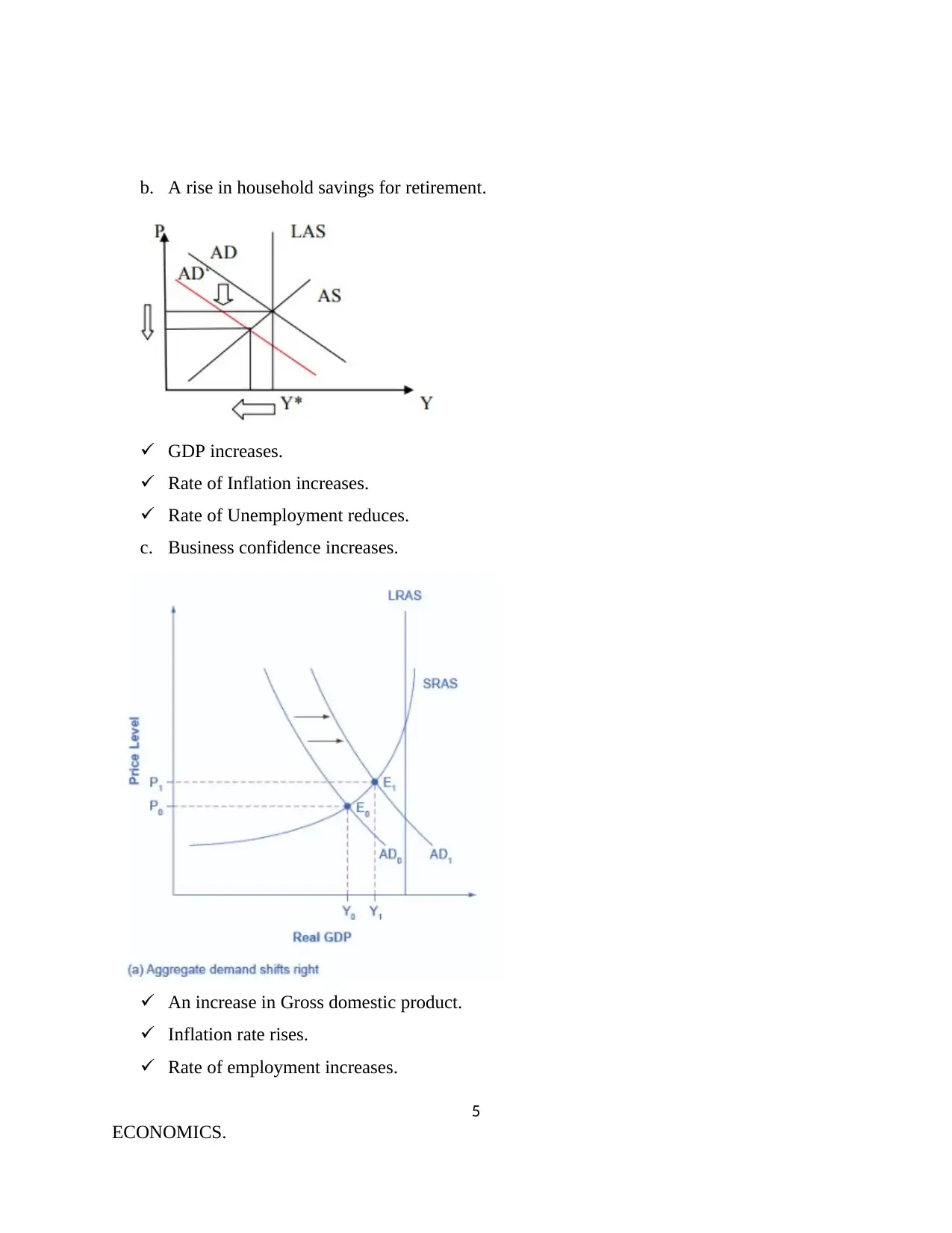
b. A rise in household savings for retirement.
GDP increases.
Rate of Inflation increases.
Rate of Unemployment reduces.
c. Business confidence increases.
An increase in Gross domestic product.
Inflation rate rises.
Rate of employment increases.
5
ECONOMICS.
GDP increases.
Rate of Inflation increases.
Rate of Unemployment reduces.
c. Business confidence increases.
An increase in Gross domestic product.
Inflation rate rises.
Rate of employment increases.
5
ECONOMICS.
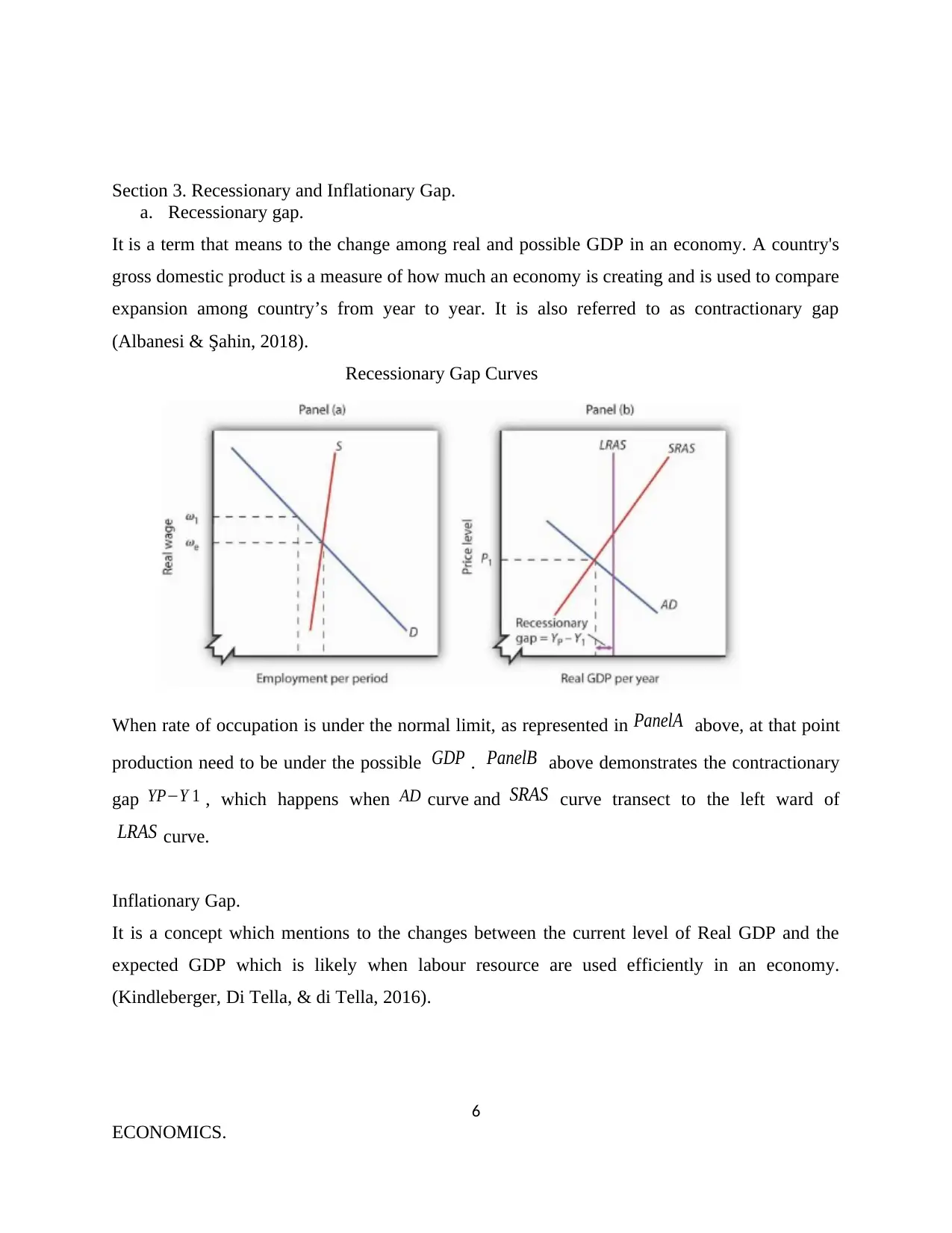
Section 3. Recessionary and Inflationary Gap.
a. Recessionary gap.
It is a term that means to the change among real and possible GDP in an economy. A country's
gross domestic product is a measure of how much an economy is creating and is used to compare
expansion among country’s from year to year. It is also referred to as contractionary gap
(Albanesi & Şahin, 2018).
Recessionary Gap Curves
When rate of occupation is under the normal limit, as represented in PanelA above, at that point
production need to be under the possible GDP . PanelB above demonstrates the contractionary
gap YP−Y 1 , which happens when AD curve and SRAS curve transect to the left ward of
LRAS curve.
Inflationary Gap.
It is a concept which mentions to the changes between the current level of Real GDP and the
expected GDP which is likely when labour resource are used efficiently in an economy.
(Kindleberger, Di Tella, & di Tella, 2016).
6
ECONOMICS.
a. Recessionary gap.
It is a term that means to the change among real and possible GDP in an economy. A country's
gross domestic product is a measure of how much an economy is creating and is used to compare
expansion among country’s from year to year. It is also referred to as contractionary gap
(Albanesi & Şahin, 2018).
Recessionary Gap Curves
When rate of occupation is under the normal limit, as represented in PanelA above, at that point
production need to be under the possible GDP . PanelB above demonstrates the contractionary
gap YP−Y 1 , which happens when AD curve and SRAS curve transect to the left ward of
LRAS curve.
Inflationary Gap.
It is a concept which mentions to the changes between the current level of Real GDP and the
expected GDP which is likely when labour resource are used efficiently in an economy.
(Kindleberger, Di Tella, & di Tella, 2016).
6
ECONOMICS.
⊘ This is a preview!⊘
Do you want full access?
Subscribe today to unlock all pages.

Trusted by 1+ million students worldwide
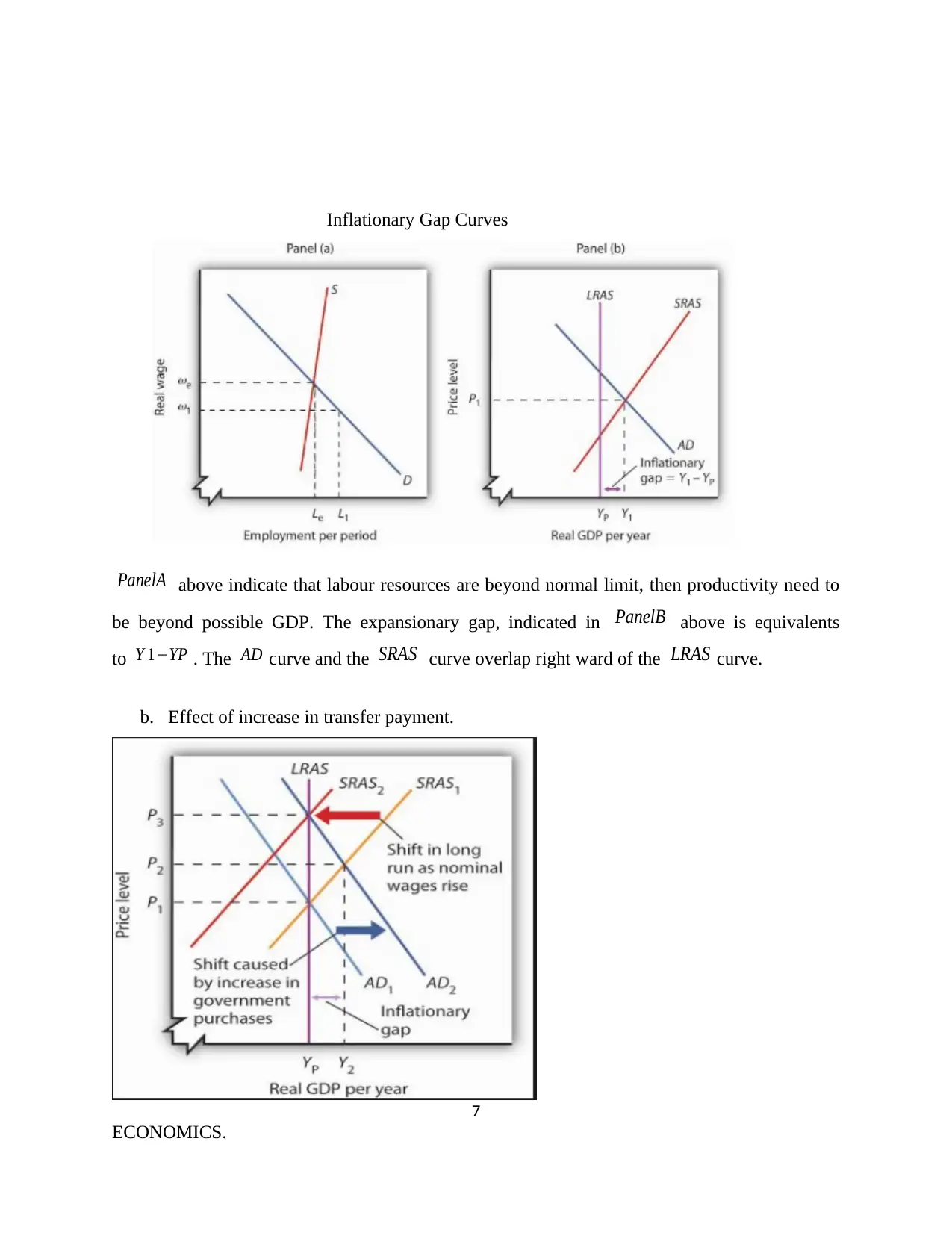
Inflationary Gap Curves
PanelA above indicate that labour resources are beyond normal limit, then productivity need to
be beyond possible GDP. The expansionary gap, indicated in PanelB above is equivalents
to Y 1−YP . The AD curve and the SRAS curve overlap right ward of the LRAS curve.
b. Effect of increase in transfer payment.
7
ECONOMICS.
PanelA above indicate that labour resources are beyond normal limit, then productivity need to
be beyond possible GDP. The expansionary gap, indicated in PanelB above is equivalents
to Y 1−YP . The AD curve and the SRAS curve overlap right ward of the LRAS curve.
b. Effect of increase in transfer payment.
7
ECONOMICS.
Paraphrase This Document
Need a fresh take? Get an instant paraphrase of this document with our AI Paraphraser

Part C: LO6–Impact of Government on the Macroeconomic Objectives.
Section 1. Government’s Macroeconomic Objectives.
Advantage.
Increased net migration raises output and growth in a country. New technological
advancement is brought to the New Zealand country and properties comprising houses and cars
are bought by immigrants in return more money is pumped into the economy.
Disadvantages.
The government of New Zealand has failed to plan for the ever increasing population of
New Zealand in terms of housing and infrastructure for the past decade therefore this rise in net
migration has gave rise to lack of housing entities for the increasing population. The
infrastructural development has also stuck for many years as compared to the increasing number
of cars being bought this has led to resident spending more time on roads due to traffic jam.
Section 2 Monetary Policy.
Monetary policy.
It is a regulation agreed by the Reserve bank. It includes of regulating of money supply and
interest rate and it is the economic regulation applied by the regime of a nation to attain broader
economic resolutions such as price rises, consumption, development and liquidity (Gertler &
Karadi, 2015).
EXPANSIONARY MONETARY POLICY
8
ECONOMICS.
Section 1. Government’s Macroeconomic Objectives.
Advantage.
Increased net migration raises output and growth in a country. New technological
advancement is brought to the New Zealand country and properties comprising houses and cars
are bought by immigrants in return more money is pumped into the economy.
Disadvantages.
The government of New Zealand has failed to plan for the ever increasing population of
New Zealand in terms of housing and infrastructure for the past decade therefore this rise in net
migration has gave rise to lack of housing entities for the increasing population. The
infrastructural development has also stuck for many years as compared to the increasing number
of cars being bought this has led to resident spending more time on roads due to traffic jam.
Section 2 Monetary Policy.
Monetary policy.
It is a regulation agreed by the Reserve bank. It includes of regulating of money supply and
interest rate and it is the economic regulation applied by the regime of a nation to attain broader
economic resolutions such as price rises, consumption, development and liquidity (Gertler &
Karadi, 2015).
EXPANSIONARY MONETARY POLICY
8
ECONOMICS.
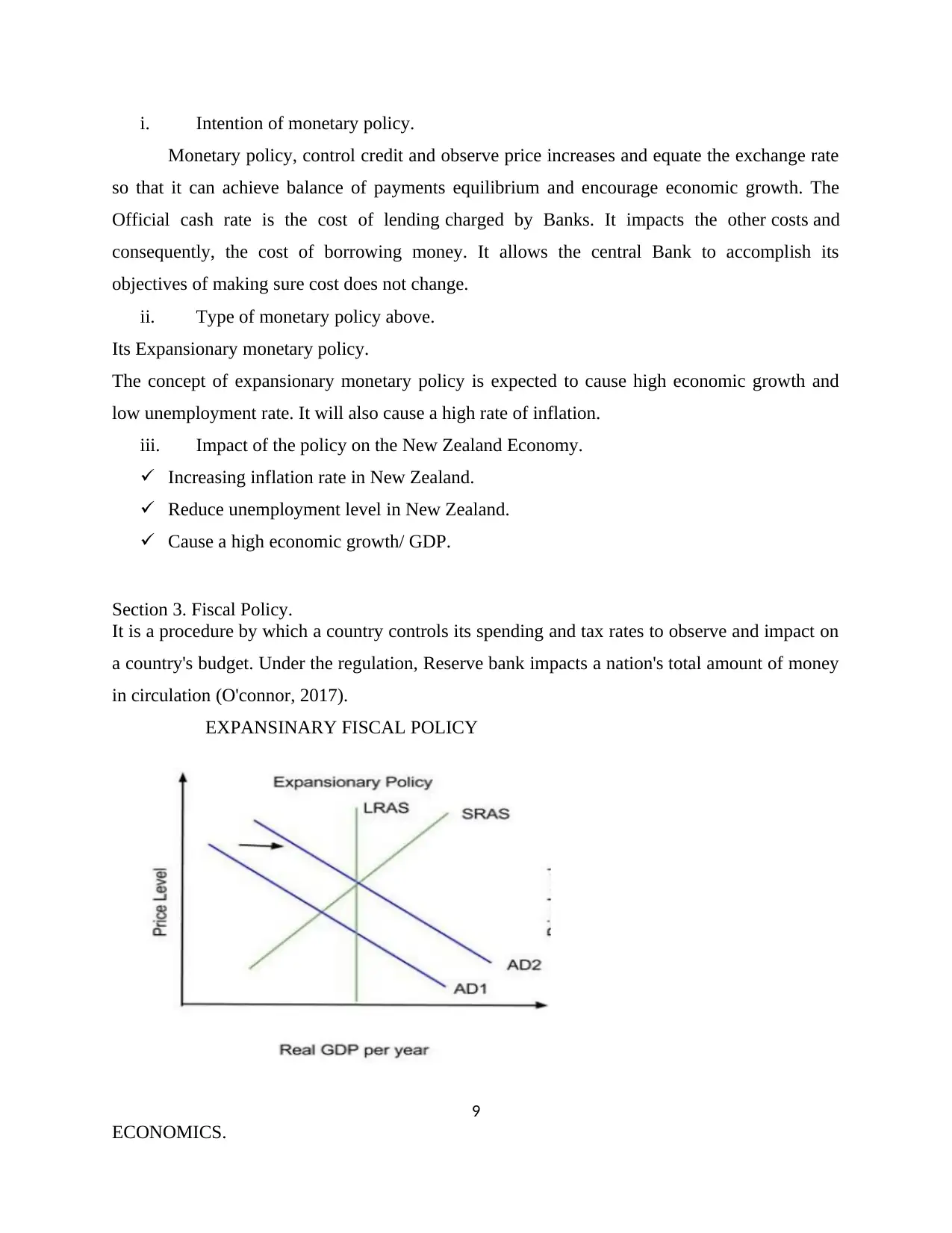
i. Intention of monetary policy.
Monetary policy, control credit and observe price increases and equate the exchange rate
so that it can achieve balance of payments equilibrium and encourage economic growth. The
Official cash rate is the cost of lending charged by Banks. It impacts the other costs and
consequently, the cost of borrowing money. It allows the central Bank to accomplish its
objectives of making sure cost does not change.
ii. Type of monetary policy above.
Its Expansionary monetary policy.
The concept of expansionary monetary policy is expected to cause high economic growth and
low unemployment rate. It will also cause a high rate of inflation.
iii. Impact of the policy on the New Zealand Economy.
Increasing inflation rate in New Zealand.
Reduce unemployment level in New Zealand.
Cause a high economic growth/ GDP.
Section 3. Fiscal Policy.
It is a procedure by which a country controls its spending and tax rates to observe and impact on
a country's budget. Under the regulation, Reserve bank impacts a nation's total amount of money
in circulation (O'connor, 2017).
EXPANSINARY FISCAL POLICY
9
ECONOMICS.
Monetary policy, control credit and observe price increases and equate the exchange rate
so that it can achieve balance of payments equilibrium and encourage economic growth. The
Official cash rate is the cost of lending charged by Banks. It impacts the other costs and
consequently, the cost of borrowing money. It allows the central Bank to accomplish its
objectives of making sure cost does not change.
ii. Type of monetary policy above.
Its Expansionary monetary policy.
The concept of expansionary monetary policy is expected to cause high economic growth and
low unemployment rate. It will also cause a high rate of inflation.
iii. Impact of the policy on the New Zealand Economy.
Increasing inflation rate in New Zealand.
Reduce unemployment level in New Zealand.
Cause a high economic growth/ GDP.
Section 3. Fiscal Policy.
It is a procedure by which a country controls its spending and tax rates to observe and impact on
a country's budget. Under the regulation, Reserve bank impacts a nation's total amount of money
in circulation (O'connor, 2017).
EXPANSINARY FISCAL POLICY
9
ECONOMICS.
⊘ This is a preview!⊘
Do you want full access?
Subscribe today to unlock all pages.

Trusted by 1+ million students worldwide
1 out of 18
Related Documents
Your All-in-One AI-Powered Toolkit for Academic Success.
+13062052269
info@desklib.com
Available 24*7 on WhatsApp / Email
![[object Object]](/_next/static/media/star-bottom.7253800d.svg)
Unlock your academic potential
Copyright © 2020–2025 A2Z Services. All Rights Reserved. Developed and managed by ZUCOL.




